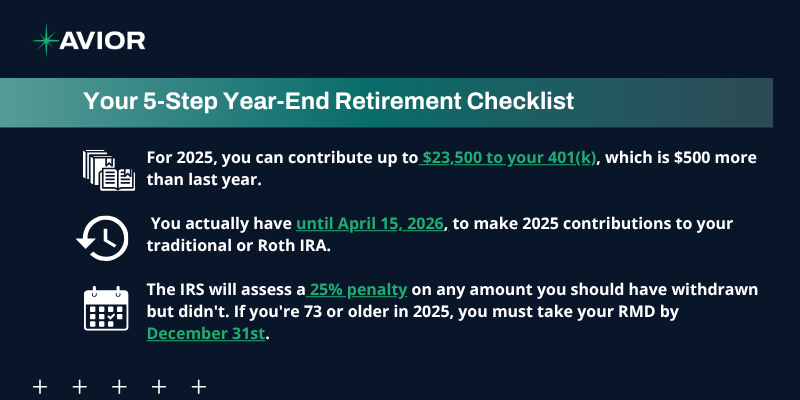Your 5-Step Year-End Retirement Checklist

December tends to sneak up on people. One moment you’re making summer vacation plans, and the next thing you know, the holiday decorations are out and the year is nearly done. While you’re thinking about gifts and gatherings, your retirement accounts might be the furthest thing from your mind.
Actually, the end of the year is one of the most important times to pay attention to your retirement planning. Missing key deadlines can cost you money, create tax headaches, or leave opportunities on the table. This isn’t about complex financial maneuvers or sophisticated strategies. These are straightforward action items that every retirement saver should check off before the calendar flips to 2026. Let’s walk through the five essential tasks that deserve your attention before December 31st.
Max Out Your Retirement Contributions
Time is running short to hit this year’s contribution limits. For 2025, you can contribute up to $23,500 to your 401(k), which is $500 more than last year. If you’re between 60 and 63, you have access to an enhanced catch-up contribution of $11,250 instead of the standard $7,500 for workers 50 and older.
Many people assume they’ve contributed enough throughout the year. Then they check their statements in late December and realize they’ve left money on the table. Even if you can’t hit the maximum, try to increase your final paycheck contributions before year-end. Every dollar you defer reduces your current taxable income while building your nest egg.
Don’t Forget About IRAs
IRA contributions work differently from workplace plans. You actually have until April 15, 2026, to make 2025 contributions to your traditional or Roth IRA. The annual limit stays at $7,000, or $8,000 if you’re 50 or older. While you have a few extra months, making the contribution before year-end has psychological benefits. You’ll start the new year with a clean slate instead of carrying over last year’s to-do list.
Take Your Required Minimum Distribution
Missing your RMD is expensive. The IRS will assess a 25% penalty on any amount you should have withdrawn but didn’t. If you’re 73 or older in 2025, you must take your RMD by December 31st. This applies to traditional IRAs, 401(k)s, 403(b)s, and most other retirement accounts.
Roth IRAs don’t require distributions during your lifetime. But if you inherited an IRA from someone who died on or after January 1, 2020, you might have distribution requirements under the 10-year rule. These rules get complicated fast, so double-check your specific situation.
Calculate Your Distribution Amount
Your RMD is based on your account balance from December 31, 2024, divided by your life expectancy factor from the IRS tables. Most financial institutions will calculate this for you and send notifications. Still, don’t wait for them to do it. Log into your accounts, verify the calculation, and initiate the withdrawal with enough time for it to process before the deadline.
Review Your Beneficiary Designations
Life changes happen throughout the year. Marriages, divorces, births, deaths, any of these events should trigger a beneficiary review. Yet most people set their beneficiaries when they open an account and never look at them again.
Your beneficiary designations override your will. If you got divorced but never updated your 401(k) beneficiary, your ex-spouse might still receive those assets regardless of what your will says. Pull up every retirement account you own and verify the primary and contingent beneficiaries are still who you want.
Check for Forgotten Accounts
The average baby boomer American worker held over 12 jobs in their lifetime. Each job might have come with a retirement plan. Some people have old 401(k) accounts sitting with former employers that they’ve completely forgotten about. The Department of Labor now maintains a searchable database to help you track down these lost accounts. Search for them before year-end and decide whether to consolidate or leave them where they are.
Rebalance Your Portfolio
Market movements throughout the year can throw your asset allocation out of whack. Maybe you started 2025 with a 70/30 stock-to-bond ratio. After the market’s ups and downs, you might now be sitting at 75/25 or 65/35. These shifts expose you to more or less risk than you intended.
End-of-year is a natural checkpoint to bring your portfolio back in line. Sell some assets that have grown too large and buy others that have shrunk below your target. This forces you to sell high and buy low, which is exactly what you should be doing even though it feels wrong in the moment.
Consider Tax-Loss Harvesting
Selling investments at a loss isn’t fun. But those losses can reduce your taxable income for the year. Look through your taxable accounts for positions that are underwater. If selling them makes sense for your overall strategy, you can use those losses to offset capital gains elsewhere in your portfolio. Just watch out for the wash-sale rule, which prevents you from buying the same security within 30 days of selling it for a loss.
Optimize Your Tax Strategy
Your retirement contributions, distributions, and investment moves all have tax implications. The last few weeks of the year give you a final chance to minimize your 2025 tax bill. Consider whether it makes sense to accelerate income into this year or defer it to next year based on your expected tax bracket.
If you’re charitably inclined and over 70½, qualified charitable distributions from your IRA can satisfy your RMD while avoiding income tax on the distribution. You can direct up to $105,000 to charity this way in 2025. The donation counts toward your RMD but doesn’t add to your adjusted gross income, which can help with Medicare premium calculations and other income-based thresholds.
Work With Us
Year-end retirement planning doesn’t need to feel overwhelming, but it does require attention to detail and knowledge of current rules. The five steps we’ve covered, maxing contributions, taking RMDs, updating beneficiaries, rebalancing your portfolio, and optimizing taxes, can make a meaningful difference in your retirement security. Small actions taken before December 31st can save you thousands of dollars or position you for better returns down the road.
At Avior, we help clients stay on top of these critical year-end tasks while keeping their long-term retirement vision in focus. Our team understands the changing rules around contributions, RMDs, and tax strategies so you don’t have to become an expert yourself. If you’d like help reviewing your retirement accounts before the year ends or want to develop a comprehensive strategy for 2026 and beyond, we’re here to guide you through every step. Schedule a consultation with our team today, and let’s make sure your retirement plan is positioned for success.
No Comments
Sorry, the comment form is closed at this time.



